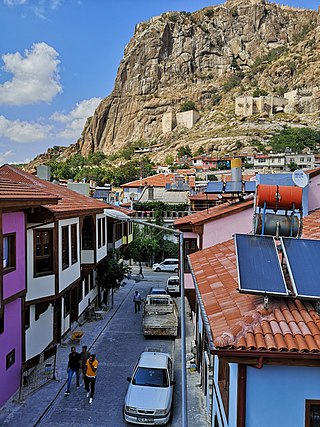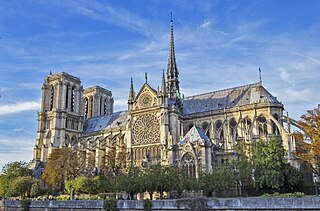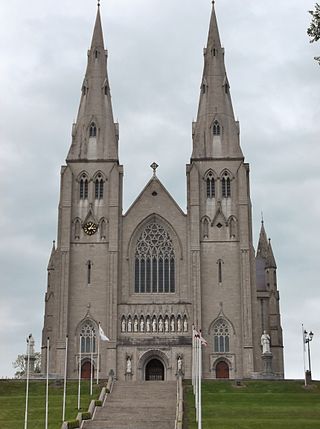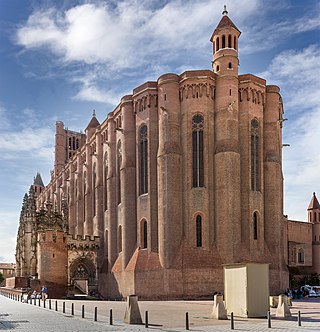
Alabaster is a mineral and a soft rock used for carvings and as a source of plaster powder. Archaeologists, geologists, and the stone industry have different definitions for the word alabaster. In archaeology, the term alabaster includes objects and artefacts made from two different minerals: (i) the fine-grained, massive type of gypsum, and (ii) the fine-grained, banded type of calcite.

Afyonkarahisar is a city in western Turkey. It is the administrative centre of Afyonkarahisar Province and Afyonkarahisar District. Its population is 251,799 (2021). Afyon is in the mountainous countryside inland from the Aegean coast, 250 km (155 mi) south-west of Ankara along the Akarçay River. In Turkey, Afyonkarahisar stands out as a capital city of hot springs and spas, an important junction of railway, highway and air traffic in West-Turkey, and the place where independence was won. In addition, Afyonkarahisar is one of the top leading provinces in agriculture, globally renowned for its marble and is the world's largest producer of pharmaceutical opium. In antiquity the city was called Akroinon and it is the site of Afyonkarahisar Castle.

Marble is a metamorphic rock consisting of carbonate minerals (most commonly calcite (CaCO3) or dolomite (CaMg(CO3)2) that have recrystallized under the influence of heat and pressure. It has a crystalline texture, and is typically not foliated (layered), although there are exceptions.

The Pyrenees are a mountain range straddling the border of France and Spain. They extend nearly 500 km (310 mi) from their union with the Cantabrian Mountains to Cap de Creus on the Mediterranean coast, reaching a maximum altitude of 3,404 metres (11,168 ft) at the peak of Aneto.

Romanesque architecture is an architectural style of medieval Europe that was predominant in the 11th and 12th centuries. The style eventually developed into the Gothic style with the shape of the arches providing a simple distinction: the Romanesque is characterized by semicircular arches, while the Gothic is marked by the pointed arches. The Romanesque emerged nearly simultaneously in multiple countries ; its examples can be found across the continent, making it the first pan-European architectural style since Imperial Roman architecture. Similarly to Gothic, the name of the style was transferred onto the contemporary Romanesque art.

Notre-Dame de Paris, often referred to simply as Notre-Dame, is a medieval Catholic cathedral on the Île de la Cité, in the 4th arrondissement of Paris, France. The cathedral, dedicated to the Virgin Mary, is considered one of the finest examples of French Gothic architecture. Several attributes set it apart from the earlier Romanesque style, including its pioneering use of the rib vault and flying buttress, its enormous and colourful rose windows, and the naturalism and abundance of its sculptural decoration. Notre-Dame is also exceptional for its three pipe organs and its immense church bells.

Carrara marble, or Luna marble to the Romans, is a type of white or blue-grey marble popular for use in sculpture and building decor. It has been quarried since Roman times in the mountains just outside the city of Carrara in the province of Massa and Carrara in the Lunigiana, the northernmost tip of modern-day Tuscany, Italy.

A marble is a small spherical object often made from glass, clay, steel, plastic, or agate. They vary in size, and most commonly are about 13 mm in diameter. These toys can be used for a variety of games called marbles, as well being placed in marble runs or races, or created as a form of art. They are often collected, both for nostalgia and for their aesthetic colors.

St. Patrick's Cathedral in Armagh, Northern Ireland is the seat of the Catholic Archbishop of Armagh, Primate of All Ireland. It was built in various phases between 1840 and 1904 to serve as the Roman Catholic cathedral of the Archdiocese of Armagh, the original medieval Cathedral of St. Patrick having been appropriated by the state church called the Church of Ireland at the time of the Irish Reformation.

St. Mary's Cathedral of the Immaculate Conception is the seat of the Roman Catholic Archdiocese of Portland in Portland, Oregon, United States and serves Roman Catholics in western Oregon.

Cosmatesque, or Cosmati, is a style of geometric decorative inlay stonework typical of the architecture of Medieval Italy, and especially of Rome and its surroundings. It was used most extensively for the decoration of church floors, but was also used to decorate church walls, pulpits, and bishop's thrones. The name derives from the Cosmati, the leading family workshop of craftsmen in Rome who created such geometrical marble decorations.

The Cosmati were a Roman family, seven members of which, for four generations, were skilful architects, sculptors and workers in decorative geometric mosaic, mostly for church floors. Their name is commemorated in the genre of Cosmatesque work, often just called "Cosmati", a technique of opus sectile formed of elaborate inlays of small triangles and rectangles of colored stones and glass mosaics set into stone matrices or encrusted upon stone surfaces. Bands, panels and shaped reserves of intricate mosaic alternate with contrasting bands, guilloches and simple geometric shapes of plain white marble. Pavements and revetments were executed in Cosmatesque technique, columns were inlaid with fillets and bands, and immovable church furnishings like cathedras and ambones were similarly treated. Initial inspiration for the technique was Byzantine, transmitted through Ravenna and Sicily, while some of the minutely-figured tiling patterns are Islamic in origin, transmitted through Sicily.

Docimium, Docimia or Docimeium was an ancient city of Phrygia, Asia Minor where there were famous marble quarries. The exact site of Docimium was a matter of some dispute until recently; it is now fixed at the modern Turkish town İscehisar, in Afyonkarahisar Province.

Griotte de Kleparow is a dark-red morello, or Griotte, type of cherry which originated from the outskirts of Lviv, modern Ukraine.

Noir Belge is collective noun referring to black limestone found on several sites in Belgium. Some trade names refer more specifically to the quarry where the material was found, for example "Noir de Mazy" or "Noir de Golzinne". Some Noir belge marble deposit belongs to a fine-grained calcareous sedimentary formation dated Frasnian era and located on the northern border of Namur sedimentary basin. A few black limestones located in the lower Carboniferous

Caunes-Minervois is a small medieval town and commune in the Aude department in the Occitanie region in southern France. It is known particularly for its ancient Abbey, dating from the eighth century, and the outstanding red marble that has been quarried locally from Roman times. The name may derive from the ancient local Occitan word for cave, "cauna", of which there are a number in the immediate area.

Farmer & Brindley was a firm of architectural sculptors and ornamentalists based in London, founded by William Farmer (1825–1879) and William Brindley (1832–1919).
The Canaveilles Group is the basal metasedimentary succession of late Neoproterozoic and Cambrian age outcropping in the Pyrenees.

Southern French Gothic, or Meridional Gothic, is a specific and militant style of Gothic architecture developed in the South of France, especially in the Toulouse region. It arose in the early 13th century following the victory of the Catholic church over the Cathars, as the church sought to re-establish its authority in the region. As a result, church buildings typically present features drawn from military architecture. Taking into account the Cathars' criticism of the Catholic Church, Southern French Gothic is simpler and less ornate than northern French Gothic, and further differs in that the construction material is typically brick rather than stone. Over time, the style came to influence secular buildings as well as churches and spread beyond the area where Catharism had flourished.


















